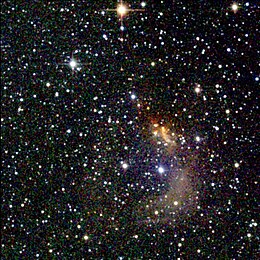| Reflection nebula | |
|---|---|
 Atlas Image mosaic of NGC 2626, which, at a distance of about 1 kpc (3300 light years), is primarily reflecting the light from the bright blue (B1-type) 10th-magnitude star, CD-40° 4432, which is embedded in it. | |
| Observation data: J2000 epoch | |
| Right ascension | 08h 35m 32s[1] |
| Declination | −40° 40′ 18″[1] |
| Distance | 3900 ± 1110 ly (1200 ± 340[2] pc) |
| Apparent dimensions (V) | 5.0′ × 5.0′[3] |
| Constellation | Vela |
| Designations | NGC 2626, Ced 106h, GN 08.33.7, VdBH 17 |
NGC 2626 is a reflection nebula, emission nebula, and absorption nebula in the constellation Vela.[4][5] It is mostly illuminated by B1 star CD-40 4432 and ionized by the O8 quadruple star system HD 73882, together with other stars.
Gallery
[edit]-
This image has been produced using observations made at the SMARTS 0.9-meter Telescope at the Cerro Tololo Inter-American Observatory (CTIO)[6]
See also
[edit]References
[edit]- ^ a b "NGC 2626". SIMBAD. Centre de données astronomiques de Strasbourg. Retrieved 11 August 2017.
- ^ Pinheiro, M. C.; Copetti, M. V. F.; Oliveira, V. A. (2010). "Spectral classification and distance determination of stars in nine southern Galactic H II regions". Astronomy and Astrophysics. 521: A26. Bibcode:2010A&A...521A..26P. doi:10.1051/0004-6361/200912937.
- ^ Seligman, Courtney. "New General Catalogue objects: NGC 2600 - 2649". cseligman.com. Retrieved 11 August 2017.
- ^ Mueller, Kaisa; Graham, John A (November 2000). "Young Stars Associated with the Reflection Nebula NGC 2626". Publications of the Astronomical Society of the Pacific. 112 (777): 1426–32. Bibcode:2000PASP..112.1426M. doi:10.1086/317705. JSTOR 10.1086/317705. S2CID 121268925.
- ^ Harvey, J.; Mazlin, S.; Verschatse, D.; Perez, J. J. (September 2014). "Rarely Imaged". Astronomy: 89.
- ^ "A Vista of NGC 2626 with the SMARTS 0.9-meter Telescope". Retrieved April 20, 2021.
External links
[edit] Media related to NGC 2626 at Wikimedia Commons
Media related to NGC 2626 at Wikimedia Commons
![This image has been produced using observations made at the SMARTS 0.9-meter Telescope at the Cerro Tololo Inter-American Observatory (CTIO)[6]](Https://upload.wikimedia.org/wikipedia/commons/thumb/c/cd/A_Vista_of_NGC_2626_with_the_SMARTS_0.9-meter_Telescope.jpg/270px-A_Vista_of_NGC_2626_with_the_SMARTS_0.9-meter_Telescope.jpg)
Well, that’s interesting to know that Psilotum nudum are known as whisk ferns. Psilotum nudum is the commoner species of the two. While the P. flaccidum is a rare species and is found in the tropical islands. Both the species are usually epiphytic in habit and grow upon tree ferns. These species may also be terrestrial and grow in humus or in the crevices of the rocks.
View the detailed Guide of Psilotum nudum: Detailed Study Of Psilotum Nudum (Whisk Fern), Classification, Anatomy, Reproduction